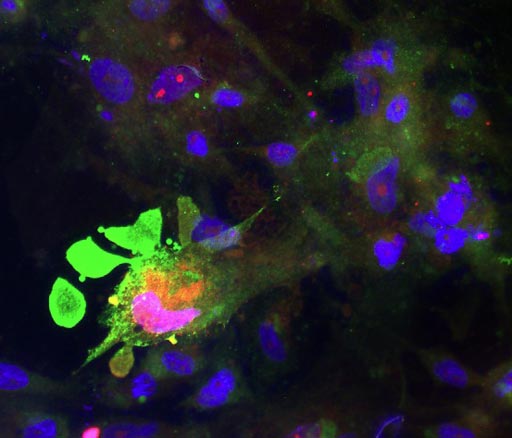Biomarker Panel Enables Diagnosis of Mild Concussions
By LabMedica International staff writers
Posted on 06 Nov 2017
A panel comprising proteins released into the blood by damaged brain astrocytes was shown to be diagnostic for mild concussions, even those that could not be detected by CAT scan.Posted on 06 Nov 2017
Concussion, also referred to as mild traumatic brain injury (TBI), is an expanding public health problem with pathophysiology that is difficult to diagnose and thus treat. TBI biomarkers should assess patients across severities and reveal pathophysiology, but currently, their kinetics and specificity are unclear. No single ideal TBI biomarker exists.

Image: A fluorescence micrograph of a human astrocyte (Photo courtesy of Wikimedia Commons).
Following a search for TBI biomarkers, investigators at the University of California, Los Angeles (USA) reported that they had identified new candidates by selecting trauma-released, astrocyte-enriched proteins including the enzyme aldolase C (ALDOC), its 38 kiloDalton breakdown product (BDP), brain lipid binding protein (BLBP), astrocytic phosphoprotein (PEA15), glutamine synthetase (GS) and new 18-25 kiloDalton GFAP (Glial fibrillary acidic protein)-BDPs.
The investigators reported that levels of these proteins increased over four orders of magnitude in severe TBI cerebrospinal fluid (CSF). First post-injury week, ALDOC levels were markedly high and stable. Short-lived BLBP and PEA15 related to injury progression. ALDOC, BLBP, and PEA15 appeared soon after the injury and were robust in the blood of severe and mild TBI patients; 25 kiloDalton GFAP-BDP appeared overnight after TBI and was rarely present after mild TBI.
Using a human culture trauma model, the investigators analyzed biomarker kinetics. They found that disrupted astrocytes released ALDOC, BLBP, and PEA15 acutely. Delayed cell death corresponded with GFAP release and proteolysis into small GFAP-BDPs.
The investigators suggested that this biomarker panel would make it possible for the first time to diagnose mild traumatic brain injury and to monitor brain tissue damage as it occurs.
Related Links:
University of California, Los Angeles













